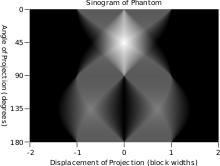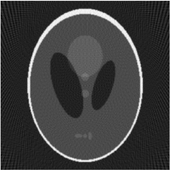Radon transform



In mathematics, the Radon transform is the integral transform which takes a function f defined on the plane to a function Rf defined on the (two-dimensional) space of lines in the plane, whose value at a particular line is equal to the line integral of the function over that line. The transform was introduced in 1917 by Johann Radon,[1] who also provided a formula for the inverse transform. Radon further included formulas for the transform in three dimensions, in which the integral is taken over planes. It was later generalized to higher-dimensional Euclidean spaces, and more broadly in the context of integral geometry. The complex analog of the Radon transform is known as the Penrose transform.The Radon transform is widely applicable to tomography, the creation of an image from the projection data associated with cross-sectional scans of an object.
Explanation
If a function represents an unknown density, then the Radon transform represents the projection data obtained as the output of a tomographic scan. Hence the inverse of the Radon transform can be used to reconstruct the original density from the projection data, and thus it forms the mathematical underpinning for tomographic reconstruction, also known as image reconstruction.
The Radon transform data is often called a sinogram because the Radon transform of an off-center point source is a sinusoid. Consequently the Radon transform of a number of small objects appears graphically as a number of blurred sine waves with different amplitudes and phases.
The Radon transform is useful in computed axial tomography (CAT scan), barcode scanners, electron microscopy of macromolecular assemblies like viruses and protein complexes, reflection seismology and in the solution of hyperbolic partial differential equations.
Definition
The (n-dimensional) Radon transform maps a function on into the set of its integrals over the hyperplanes of . More specifically, if and ,then
is the integral of over the hyperplane perpendicular to with (signed) distance from the origin.[2]
In the 2D case, the Radon transform can be expressed as
Concretely, the parametrization of any straight line L with respect to arc length z can always be written
where s is the distance of L from the origin and is the angle the normal vector to L makes with the x axis. It follows that the quantities (α,s) can be considered as coordinates on the space of all lines in R2, and the Radon transform can be expressed in these coordinates by
Relationship with the Fourier transform
The Radon transform is closely related to the Fourier transform. For a function of one variable the Fourier transform is defined by
and for a function of a 2-vector ,
For convenience, denote . The Fourier slice theorem then states
where
Thus the two-dimensional Fourier transform of the initial function along a line at the inclination angle is the one variable Fourier transform of the Radon transform (acquired at angle ) of that function.
More generally, one has the result valid in n dimensions
Dual transform
The dual Radon transform is a kind of adjoint to the Radon transform. Beginning with a function g on the space Σn, the dual Radon transform is the function on Rn defined by
The integral here is taken over the set of all lines incident with the point x ∈ Rn, and the measure dμ is the unique probability measure on the set invariant under rotations about the point x.
Concretely, for the two-dimensional Radon transform, the dual transform is given by
In the context of image processing, the dual transform is commonly called backprojection[3] as it takes a function defined on each line in the plane and 'smears' or projects it back over the line to produce an image.
Intertwining property
Let Δ denote the Laplacian on Rn:
This is a natural rotationally invariant second-order differential operator. On Σn, the "radial" second derivative
is also rotationally invariant. The Radon transform and its dual are intertwining operators for these two differential operators in the sense that[4]
Reconstruction approaches
The process of reconstruction produces the image (or function in the previous section) from its projection data. Reconstruction is an inverse problem.
Radon inversion formula
In the 2D case, the most commonly used analytical formula to recover from its Radon transform is the Filtered Backprojection Formula or Radon Inversion Formula:
where is such that . [6]
The convolution kernel is referred to as Ramp filter in some literature.
Ill-posedness
Intuitively, in the filtered backprojection formula, by analogy with differentiation, for which , we see that the filter performs an operation similar to a derivative. Roughly speaking, then, the filter makes objects more singular.
A quantitive statement of the ill-posedness of Radon Inversion goes as follows:
We have
where is the previously defined adjoint to the Radon Transform.
Thus for ,
- .
The complex exponential is thus an eigenfunction of with eigenvalue . Thus the singular values of are . Since these singular values tend to 0, is unbounded. [6]
Iterative Reconstruction methods
Compared with the Filtered Backprojection method, iterative reconstruction costs large computation time, limiting its pratical use. However, due to the ill-posedness of Radon Inversion, the Filtered Backprojection method may be infeasible in the presence of discontinuity or noise. The iterative reconstruction could provide metal artifact reduction, noise and dose reduction for the reconstructed result that attract much research interest around the world. [7]
See also
- Deconvolution
- X-ray transform
- Funk transform
- The Hough transform, when written in a continuous form, is very similar, if not equivalent, to the Radon transform.[8]
- Cauchy-Crofton theorem is a closely related formula for computing the length of curves in space.
- Fourier transform
Notes
- ↑ Radon 1917.
- ↑ Natterer, F. (1986). The Mathematics of Computerized Tomography. p. 9. ISBN 0 471 90959 9.
- ↑ Roerdink 2001
- ↑ Helgason 1984, Lemma I.2.1
- ↑ Candès, Emmanuel. "Applied Fourier Analysis and Elements of Modern Signal Processing - Lecture 9" (PDF).
- 1 2 Candès, Emmanuel. "Applied Fourier Analysis and Elements of Modern Signal Processing - Lecture 10" (PDF).
- ↑ Lalush, David. "Iterative reconstruction methods and applications" (PDF).
- ↑ van Ginkel, M.; Luengo Hendricks, C.L.; van Vliet, L.J. "A short introduction to the Radon and Hough transforms and how they relate to each other" (PDF). Archived (PDF) from the original on 2016-07-29.
References
- Deans, Stanley R. (1983), The Radon Transform and Some of Its Applications, New York: John Wiley & Sons.
- Helgason, Sigurdur (2008), Geometric analysis on symmetric spaces, Mathematical Surveys and Monographs, 39 (2nd ed.), Providence, R.I.: American Mathematical Society, ISBN 978-0-8218-4530-1, MR 2463854.
- Helgason, Sigurdur (1984), Groups and Geometric Analysis: Integral Geometry, Invariant Differential Operators, and Spherical Functions, Academic Press, ISBN 0-12-338301-3.
- Herman, Gabor T. (2009), Fundamentals of Computerized Tomography: Image Reconstruction from Projections (2nd ed.), Springer, ISBN 978-1-85233-617-2.
- Minlos, R.A. (2001), "Radon transform", in Hazewinkel, Michiel, Encyclopedia of Mathematics, Springer, ISBN 978-1-55608-010-4.
- Natterer, Frank, The Mathematics of Computerized Tomography, Classics in Applied Mathematics, 32, Society for Industrial and Applied Mathematics, ISBN 0-89871-493-1
- Natterer, Frank; Wübbeling, Frank, Mathematical Methods in Image Reconstruction, Society for Industrial and Applied Mathematics, ISBN 0-89871-472-9.
- Radon, Johann (1917), "Über die Bestimmung von Funktionen durch ihre Integralwerte längs gewisser Mannigfaltigkeiten", Berichte über die Verhandlungen der Königlich-Sächsischen Akademie der Wissenschaften zu Leipzig, Mathematisch-Physische Klasse [Reports on the proceedings of the Royal Saxonian Academy of Sciences at Leipzig, mathematical and physical section], Leipzig: Teubner (69): 262–277; Translation: Radon, J.; Parks, P.C. (translator) (1986), "On the determination of functions from their integral values along certain manifolds", IEEE Transactions on Medical Imaging, 5 (4): 170–176, doi:10.1109/TMI.1986.4307775, PMID 18244009.
- Roerdink, J.B.T.M. (2001), "Tomography", in Hazewinkel, Michiel, Encyclopedia of Mathematics, Springer, ISBN 978-1-55608-010-4.
- Weisstein, Eric W. "Radon transform". MathWorld.
.

